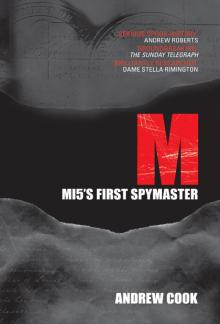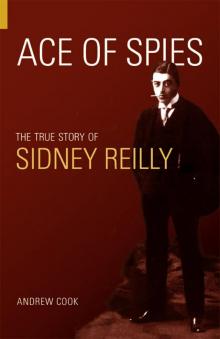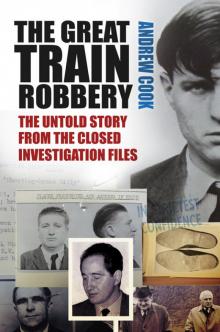M Read online
M15’S FIRST SPYMASTER
ABOUT THE AUTHOR
Andrew Cook worked for many years as a foreign affairs and defence specialist, and the contacts he made enabled him to navigate and gain access to classified intelligence services archives. He is only the fifth historian to be given special permission under the 1992 ‘Waldegrave Initiative’ by the Cabinet Office to examine closed MI5 documents that will never be released. He is author of critically acclaimed Ace of Spies: The True Story of Sidney Reilly, To Kill Rasputin: The Life and Death of Grigori Rasputin and Prince Eddy: The King Britain Never Had, all published by Tempus. He was the historical consultant for the recent BBC Timewatch documentary on Rasputin, and was presenter and historical consultant for the Channel 4 documentary about the life of Prince Albert Victor. He is a regular contributor on espionage history to The Guardian, The Times and History Today. He lives in Bedfordshire.
M15’S FIRST SPYMASTER
ANDREW COOK
First published in 2006
The History Press
The Mill, Brimscombe Port
Stroud, Gloucestershire, GL5 2QG
www.thehistorypress.co.uk
This ebook edition first published in 2011
All rights reserved
© Andrew Cook, 2004, 2006, 2011
The right of Andrew Cook to be identified as the Author of this work has been asserted in accordance with the Copyrights, Designs and Patents Act 1988.
This ebook is copyright material and must not be copied, reproduced, transferred, distributed, leased, licensed or publicly performed or used in any way except as specifically permitted in writing by the publishers, as allowed under the terms and conditions under which it was purchased or as strictly permitted by applicable copyright law. Any unauthorised distribution or use of this text may be a direct infringement of the author’s and publisher’s rights, and those responsible may be liable in law accordingly.
EPUB ISBN 978 0 7524 6961 4
MOBI ISBN 978 0 7524 6962 1
Original typesetting by The History Press
CONTENTS
About the Author
Acknowledgements
Preface
Principal Characters
1 The Man From Kerry
2 Dynamite Campaign
3 Plot and Counterplot
4 A Very Dangerous Game
5 War on Terror
6 A Man to be Trusted
7 The Lodging House
8 W. Morgan, General Agent
9 Shifting Sands
10 The Bureau
11 Drift to War
12 G Men
Appendix: Bill Fitzgerald Interview
Abbreviations
Notes
Bibliography
ACKNOWLEDGEMENTS
I am greatly indebted to all those who have assisted me at the various stages of this project.
In particular, my thanks go to the Melville family, both in Ireland and New Zealand, and to HM Government. As a result of an approach to the Cabinet Office, the Government agreed to provide me with a briefing based on the records of William Melville’s service with the War Office for the purpose of this book. I am equally indebted to Lindsay Clutterbuck, Steve Earl, Tom Oakley and John Ross of the London Metropolitan Police for their assistance with New Scotland Yard records and archival material.
I am also grateful to the following individuals who have helped me at various stages of my research: Michel Ameuw (France), Dr Michael Attias (UK), Jordan Auslander (USA), Dmitri Belanovskii (Russia), Marc Bernstein (USA), Jackie and Teresa Cahill (Kenmare), Dan Downing (Sneem Parish News), John Fitzpatrick (Sneem), Michael Gasson (BP Archive), David Humphries (PRO), Rajesh Kalyan (UK), Carol Leadenham (Hoover Institution, Stanford, California), Ken Linge (DABS Forensic Ltd), Aisling Lockhart (Trinity College, Dublin), Dr Sylvia Moehle (Germany), Danny Moriarty (Kenmare), Mary Morrigan (Dublin), Father Patrick Murphy (Parish Priest, Sneem), Stephen Parker (UK), Elizabeth Parkes (New Zealand), Joanna Quill (National Army Museum), Caroline Quirke (Assistant Registrar, Killarney), Rachel Sampson (BP Archive), Laura Scannell (Bar Council Archive), Graham Salt (UK) and Mark Tami MP.
I would like to thank those who have previously written on this and related subject matters for speaking or corresponding with me – Professor Christopher Andrew (Corpus Christi College, Cambridge), Gill Bennett (Chief Foreign Office Historian), Christy Campbell, Dr Nicholas Hiley (University of Kent), Alan Judd, Nick McCarty and Tom Wood.
The help and co-operation of the families of those who played a role in Melville’s story has been greatly appreciated, as has the assistance of Francis & Francis (private and commercial investigators) who helped in tracing them.
A special thank you also goes to Caroline Beach, Sophie Bradshaw, Jo De Vries, Elaine Enstone, Monica Finch, Ingrid Lock, Carolyn Jardine, Patrick Ooi, Janie New, Hannah Renier, Bob Sheth and Chris Williamson for their hard work at various stages of this project. Also to RP Translate Ltd for their sterling work in translating source material from Russian, German and French into English and to my publisher Jonathan Reeve for his support and advice.
PREFACE
Shortly after her retirement as Director-General of the Security Service (MI5), Dame Stella Rimington paid tribute to the founding fathers of the Service and publicly acknowledged the role of William Melville, the man ‘who came to be known as M’. At the start of the twentieth century, when London fogs – pea-soupers – blanketed the city, it was Melville who, from a small secret office in London’s Victoria Street, determinedly lobbied the Government to create an effective counter-intelligence service. Today, MI5, the organisation he strove to create, is a household name and one of the world’s leading intelligence agencies.
Melville talked to kings and murderers, con men and wily diplomats; he had a way of getting what he wanted from them all. In his day he was a master of detection. He had a devious mind and a bleakly humorous view of humanity, and because he understood the motive of the criminal or the desperate, he was able to pioneer methods and tactics that still work – today, methods improved by advanced technology.
Melville was the son of a publican in rural Ireland. Guileful and single-minded, he came to London when it was the hub of the Empire and worked his way through the ranks of the Metropolitan Police. As the most famous detective in England and head of Scotland Yard’s Special Branch, he retired at the start of the new century and disappeared from public view. The enduring achievement of his life lay ahead: to transfer the ethos and practices of detection to the War Office, its spies and agents all over the world.
He died in 1918, and eighty years passed before his true significance as MI5’s first spymaster became apparent with the release of early Secret Service documents to the Public Record Office. Very little further documentation about Melville and his career has come into the public domain since. To piece together an accurate picture of his extraordinary life, I have drawn on as many primary sources as possible. Melville’s family and the descendants of those who played key roles in his story have been tracked down and interviewed; they have been invaluable in illuminating a life’s work that pitted Melville against Jack the Ripper, Irish terrorists, anarchist assassins and German spy rings.
Now, with the help of recently declassified records, family accounts and documents that still await official release, the full story of his incredible career can finally be told for the first time.
PRINCIPAL CHARACTERS
Sir Robert Anderson Assistant Commissioner in charge of CID, Metropolitan Police 1888–1901. Engaged by Home Office on secret Irish work 1868; ran entrapment operations against Irish Nationalists.
Arthur Balfour Nephew of Lord Salisbury, Conservative MP 1874–22. Prime Minister (1902–05), Foreign Secretary 1916–19).
Sir Edward Bradford Chief Co
mmissioner, Metropolitan Police, from 1890 following the resignation of James Monro.
William Burrell Divisional Detective Inspector, CID, Metropolitan Police, from 1888. Special Staff, MI5, from 1914.
Vladimir Burtsev Russian Revolutionary journalist and émigré. Arrested and tried for incitement to murder the Tsar in 1898.
Hector Bywater Agent, Secret Service Bureau, from 1910.
Auguste Coulon French anarchist and police informer. Suspected agent provocateur in 1891 Walsall bomb case.
Sir Henry Curtis-Bennett Barrister; defence counsel at German espionage trials in First World War. Agent, MI5, from 1916.
Sir Mansfield Cumming Head of Foreign Department, Secret Service Bureau, from 1909. Director of Secret Intelligence-Service (MI6) until 1923.
Major James Edmonds Head of Section H, Intelligence Department, War Office, from outbreak of Boer War. Head of special section, Directorate of Military Operation. Led initiative resulting in creation of Secret Service Bureau, October 1909.
Herbert Fitch Inspector, Special Branch. Resigned from Metropolitan Police January 1924.
Major Nicholas Gosselin Deputy to Edward Jenkinson, Assistant Under-Secretary, Police and Crime in Ireland, from 1884.
Arthur Hailstone Inspector, Special Branch, Metropolitan Police, from 1891. Secret Service Bureau from 1911.
Sir William Harcourt Anti-imperialist Liberal MP 1868– 1904. Home Secretary (1880–85).
Sir Edward Henry Assistant Commissioner in charge of the CID, Metropolitan Police (May 1901–March 1903). Chief Commissioner (1903–18).
Edward Jenkinson Pro-Home Ruler; Assistant Under-Secretary, police and crime in Ireland, from 1882. Recruited own spy ring and adopted covert role at Home Office.
Sir Vernon Kell German intelligence analyst, War Office from 1902. Head of Home Department, Secret Service Bureau, from 1909. Director General, MI5, until 1940.
William Knox D’Arcy Solicitor who purchased concession to prospect for oil in Persia 1901. Secured backing of British Government and Burmah Oil 1905, struck oil 1908 to form company now known as BP.
Chf. Inspector John Littlechild Inspector, Special Irish Branch. Head of Special Branch (1887–1903).
Henry Dale Long Agent, ‘W. Morgan Investigation Bureau’, from 1903. Secret Service Bureau from 1909.
Sir Melville MacNaghten Assistant Commissioner in charge of CID, 1903–13.
Sir Henry Matthews Home Secretary 1886–90. Attracted severe criticism over failure to apprehend Jack the Ripper.
Det. Sergeant Patrick McIntyre Founder member, Special Irish Branch, 1882. Head of Special Branch; reduced to ranks after disciplinary action.
General F. F. Millen Double agent. Member, Fenian Brotherhood and Clan-na-Gael; took part in unsuccessful Irish coup 1865. Named by James Monro as instigator of 1887 Jubilee Plot.
James Monro Assistant Commissioner in charge of CID, Metropolitan Police, 1884–88. Chief Commissioner until 1890.
Joseph Moroney Alias: Joseph Melville. Member, Clan-na-Gael. Involved in 1887 Jubilee Plot.
Charles Parnell Irish Nationalist MP 1875–90; Irish Leader, House of Commons 1878. Political career ruined by divorce case.
Jacob Peters Latvian revolutionary arrested for murder after Houndsditch shootings. member, Bolshevik Party; Deputy Chairman, Cheka, from 1917.
Patrick Quinn Founder member, Special Irish Branch. Superintendent and Head of Special Branch 1903–18.
Sidney Reilly Born Sigmund Rosenblum. Special Branch informer from 1896. Agent, Secret Intelligence Service (1918–22); executed by Russian secret police 1925.
Gustav Steinhauer Chief of German Secret Service; established spy network in Britain before First World War. Bodyguard to Kaiser, worked with Melville, to thwart assassination attempt on Wilhelm II.
Richard Tinsley Agent, Secret Service Bureau; provided intelligence on suspected German spies heading for Britain via Belgium.
Sir James Trotter Head of Secret Section 13, War Office. Recruited Melville 1903 to take responsibility for agent recruitment and co-ordination.
Howard Vincent Founder and first Head of Criminal Investigation Department, Metropolitan Police. Assistant Commissioner in charge of CID 1878–84.
Sir Charles Warren Chief Commissioner, Metropolitan Police 1886–88; resigned in wake of police failure to apprehend ‘Jack the Ripper’.
Adolphus ‘Dolly’ Williamson First Head of Detective Department and Head of Special Irish Branch 1882–87. Deputy to James Monro from 1887.
ONE
THE MAN FROM KERRY
A secret is no longer a secret once it is revealed.
This self-evident truth is difficult for most people to grasp. William Melville, M of the British Secret Service, had no problem with it. In the last months of his life he was persuaded to commit a brief account of his career to paper. He had, after all, been known as Le Vile Melville to revolutionaries from St Petersburg to New York; men had been jailed for conspiring to kill him. This being known, a less revelatory memoir would be hard to imagine.1
It did, however, confirm suspicion that he had not, as the public thought, retired in 1903, but instead had worked in some secret capacity at a time when MI5, according to official histories, did not yet exist.
His life’s work depended upon discretion. So did his reputation, which was the foundation of his family’s prosperity, and he was never such a fool as to threaten that. There were skeletons in Melville’s cupboard that he never expected to emerge.
Concluding his short memoir, he offered mild advice to those who proposed to embark upon a career in counter-espionage.
Above all, the mysterious manner should be avoided. It only engenders distrust. A frank and apparently open style generally gains confidence... people as a rule are not averse to seeing you again. One can joke and humbug much in a jovial manner; one can talk a great deal and say nothing.
The genial mask concealed a ruthless operator.
Melville came out of the back of beyond, but the present inhabitants of his home town would thank no one for saying so. Sneem in County Kerry is a thriving tourist centre and one of the prettiest little places in the west of Ireland, its gaily painted houses set around an old stone bridge over a tumbling stream amid greensward surrounded by hills. But at a longitude of nearly 10 degrees west of Greenwich, it is further out in the Atlantic than almost anywhere else in Europe.2
Sneem suffered badly in the famine of the 1840s. From good beginnings as the hub of many outlying cabins and cottages, with a couple of schools, a penny post to Kenmare, seven markets a year and a post of constabulary, by 1850 – when Melville was born there – Sneem had declined into no more than a sad huddle of grey houses and listless people: ‘a poor, dirty village’ in the words of one traveller.
William was the son of James and Catherine Melville. As far as we know he was their first child. Family legend3 has it that Catherine (née Connor) gave birth to him at a place called Direenaclaurig Cross (a junction of two roads) on the shore side of Kenmare Road, which leads east. The road itself had been officially called into existence some twenty years before. Until then, west of Kenmare towards Sneem and the ocean there had been no more than a track, impassable in bad weather.
Sneem in 1850 had a population of 360 living in about sixty dwellings, from the poorest one-roomed mud cabins with rags stuffing the windows to those slate-roofed, mortar-covered houses, mostly terraced, which survive today set around two triangular greens.
Having been born on 25 April 1850, William was baptised into the Roman Catholic Church the following day. There was no Irish civil registration until 1864. The baptismal record we owe to the often erratic attention of the parish priest. Father Walsh, the inspiration for Father O’Flynn in a popular song of that name, was priest in Sneem from 1829 until his death in 1866. He rarely preached a sermon from one year’s end to another and was a notorious backslider when it came to record-keeping. Speaking English and Irish, he kept the books, when he bothered, in dog Latin. He devo
ted himself to hunting, being the proud owner of six or seven greyhounds even during the famine (‘though nobody could tell how he was even able to feed himself’), as well as a collection of jackdaws and hawks; his usual garb was a battered hat and hairy suit made of buffalo skin and he and the local doctor once caused an explosion while concocting home-made gunpowder.4 We must, in the circumstances, be grateful for what little information we have.
The very poorest of the native Irish at this time lived in medieval conditions, in earth-floored dwellings having only one or two rooms. They burned turf for cooking and warmth and would share their roof with the animals overnight in winter. They had to live at subsistence level off whatever they could grow, and the animals they could keep, on any strip of land rented from English landlords. Getting cash depended on employment by these landlords on their land or at the nearest Big House. Otherwise farming and fishing, a little discreet smuggling of brandy, wine or tobacco by sea, or a skilled trade were the only options short of emigration to America or England.
Perhaps because the well-off Anglo-Irish around Sneem intermarried with each other over generations and generally put down roots, thus supporting the economy and the smuggling to a greater extent than elsewhere, the village was not entirely deserted like so many during the famine; most unusually for this time and place, the population actually increased in the ten years before William was born.
James Melville is recorded as a tenant, apparently a farmer, in the land valuation records of 1852, and in the next few years he and Catherine got enough money together to start a business in the middle of the village. They kept a bakery and also sold liquor. The traditional Irish pub with a shop at one end of the counter is still familiar.5 Quite how many children they had is uncertain. Two girls, Catherine and Mary, and three boys, survived to be baptised, and these at long intervals.6 After William came Richard in 1859, who was enrolled at the village school when he was five, and George in 1868, who does not appear on the school rolls until 1875. Unlike his brothers, William’s school attendance would appear to have been somewhat erratic to say the least, tailing off during his last year to virtual non-attendance. As the eldest, his duties in the bakery would almost certainly have come before schooling.7

 M
M Ace of Spies
Ace of Spies The Great Train Robbery
The Great Train Robbery The Ian Fleming Miscellany
The Ian Fleming Miscellany